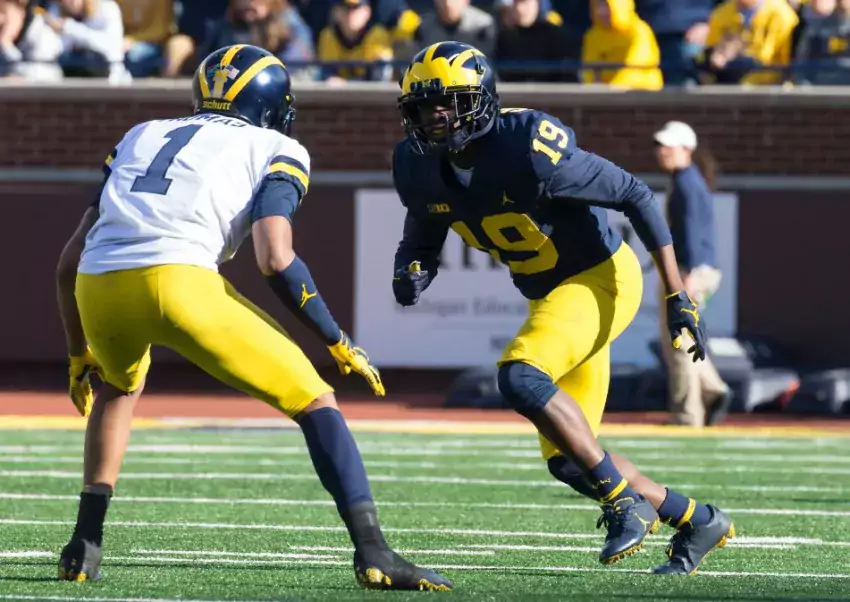
Jimmystats: Early Enrollment

The early enrollees are on campus now and I've got spreadsheets of data on starting, games played, recruiting ratings, and whatnot. I've been wondering how early enrollment affects careers ever since The Wolverine did a story on it when Kevin Grady was the first Michigan player to do it. This year's class is Blake Corum, Braiden McGregor, Aaron Lewis, Nikhai Hill-Green, Cornell Wheeler, and William Mohan. Can we expect anything different from them?
Who enrolls early?
The phenomenon didn't begin in college football until the early aughts, and Michigan got in on the game in 2005 with 5-star running back Kevin Grady.
Since the ramping up period, generally about a third of each class got here early, interrupted only when instability at Michigan led to instability in recruiting, and the plans of those who need to do a lot of foreplanning to graduate from high school a semester early.
With plenty of room for fluctuation it seems a quarter to 30 percent of a normal class enrolling early is the median. The exception of course has been right after a coaching change, as those classes came together late; recruits for whom enrolling early was a priority would not have signed with Michigan in those years.
I also wondered if a certain kind of recruit was more likely to get here early, and I found one that appears significant:
The "4.5-star" designation is for those guys who didn't get a 5th star but were in the top-100 to 150 of their classes. Reading the names from that category and those to either side, it's clear most of the early entries were players with a reasonable hope to fill an immediate roster hole or compete to play early, while most of the spring enrollees were unlikely to be on that year's two-deep.
Position also seems to have a lot to do with it:
Again, not too surprising. Quarterbacks are often recruited more in advance than their classmates, for one, but it's also the one position whose learning curve extends well past college. Lately it's become a good gambit at Michigan especially to get on campus as quickly as possible and get to a degree in 3.5 years, preserving two seasons of grad transfer eligibility (Alex Malzone and Brandon Peters have already gone this route) in case they don't win the job.
[After THE JUMP: I like charts like Quentin Tarantino likes feet.]
What Happens to Early Enrollees?
If the assumed point of enrolling early is to be ready to play earlier and get in more games over your career, has that worked out? Well...
I don't think this is statistically significant, which is notable in that you would expect the extra spring would lead to more playing time. While getting on campus faster does seem to help that freshman year, the effect wears off quickly, and gets subsumed by other factors. Take a look at the 4.5-star guys who enrolled early and had a lot of starts: Devin Gardner (33), Joe Bolden (28), Darryl Stonum (25), Bryan Mone (19), Dymonte Thomas (19), Cesar Ruiz (19), Justin Boren (14), Carlos Brown (11), and Will Campbell (11). Of those only Boren was a freshman starter. Ruiz and Mone got starts late their freshman years. On the other side you have 4.5-star fall enrollees like Craig Roh (51 starts), Ben Bredeson (49), and Terrance Taylor (36) who got on campus and played right away.
The scatter plot agrees it doesn't really matter for long careers, but it does suggest there's a difference in contrast between the guys who'll start a lot or not at all.
And I believe this is because there's a higher transfer effect going on with early enrollees:
Surprise: the impatient to start their college careers are significantly less patient when waiting their turns. Now there's a lot in there: guys leave or medical for all sorts of reasons not having to do with playing time. Also players are vastly more likely to transfer now than 20 year ago when some of the players in this study were playing. If I remove all the medicals, disciplinary/academic drops, and only stick to the 2005-2017 players who are no longer on the team, early enrollees spend an average of 3.02 years with the program while a fall enrollee spends an average of 3.71.
It's not hard to find the cause of the increased attrition either:
A few of those transfers (Boren, Mallett, Michael Ferns, and Kyle Bosch) left for personal reasons other than impatience to get on the field, but proportionally the fall enrollee transfers are even less likely (75% vs 88%) to be playing time-induced. The aggravation of being on the team and not playing is the #1 cause of attrition, and by any measure early enrollees are, for various reasons, more likely to turn that aggravation into action. Put another way: if a guy enrolls early, expect to use him or lose him.
The above gambit may not be a negative. Without resorting to over-signing, the Harbaugh program runs at a higher attrition rate by design. While the goal is always to get the best players they can, the strategy after recruiting the best has been to pack the back end with high-ceilinged prospects, and push those who don't reach them to move on. The way they do this while still making the gambit enticing to recruits is to offer a degree after three seasons of eligibility. From the player's perspective, right now you're a true freshman who can go anywhere and sit for two to three years before you know if you're able to play Power 5 football. In three years you could have a Michigan degree, three years of coaching from an elite staff, and the freedom to transfer/play immediately for the back half of your college eligibility anywhere you please. And the key to accessing that player/team option year: early enrollment.
I also looked to see if the added semester in college helped with the NFL. Doesn't look like it, though sample size here means we're lucky to even have the spread we have (click to read all the names):
There's been some data lately that suggest leaving early for the NFL leads to a shorter NFL career
The Curious Case of 2017
Since we're at that crucible now with the 2017 class, and since that class is going to represent the seniors and redshirt juniors of next season, and since that class had a Michigan-record 12 early enrollees, it's worth diving into that group as a case study. Also since half of it's gone, with four more guys either rumored to be announcing a transfer or buried on the depth chart. I asterisked those who redshirted in 2017 and highlighted the early enrollees:
| YEARS OF ELIGIBILITY LOST TO ATTRITION | ||||||
| Pos | Still with team | One | Two | Three | Four | Players |
|---|---|---|---|---|---|---|
| QB | McCaffrey* | 1 | ||||
| RB | Samuels | Taylor* | 2 | |||
| FB | Mason | 1 | ||||
| WR | Collins | DPJ | Black* | Martin* | 4 | |
| OL | Steuber*, Honigford*, Filiaga* | Ruiz | Hudson* | Hall* | 6 | |
| DT | Jeter*? Paea? | Solomon | Irving-Bey* | 4 | ||
| DE | Paye, Vilain* | CMH* | 3 | |||
| LB | Ross | Anthony* | Singleton* | 3 | ||
| Safety | Hawkins | Woods | 2 | |||
| CB | Thomas | JKP* | St-Juste | 3 | ||
| ST | Robbins | 1 | ||||
| TOTAL | 14 | 3 | 5 | 5 | 3 | 30 |
As plenty of alarmists have pointed out, this is a LOT of attrition. This class however was also set up for it—Michigan recruited this class off of a high point—a playoff-caliber team with a Heisman candidate that anyone watching knew deserved to win the Big Ten East. That team was also losing most of the playable guys inherited from Hoke all at once, going into the 2017 season super-young with most positions wide open for early playing time. And since recruiting starts in earnest when you see who makes varsity in high school, it was also the first class that Harbaugh's staff wasn't playing catch-up on. This was an ideal setup to offer early playing time to the type of highly coveted recruits who value it.
We can dispense with some of the attrition right away: Ja'Raymond Hall took one look at the competition at Michigan and realized he wasn't going to have a shot. Corey Malone-Hatcher medically retired after spring. Deron Irving-Bey's sudden drop-out made more sense when he was ruled out academically from Central Michigan. Kurt Taylor was behind from the get-go. O'Maury Samuels was dismissed for off-field issues. Peoples-Jones and Ruiz took bona fide NFL opportunities. A few of the question marks are buried on the depth chart and if they received firm handshakes with their degrees it wouldn't be any different than the way things were done under Carr. We learned today that Kelly-Powell is leaving, and it wouldn't be too surprising to lose the two DTs given they're behind Mazi/Hinton.
Then there's the strange—and still lamented—loss of Aubrey Solomon. The story, as best as I can piece it together, is that Aubrey and his camp were overly concerned about him playing with any kind of injury, which is understandable from any human's perspective, but also quite a demand in a sport where everybody's playing hurt by the end of the season. To my knowledge he wasn't much of an impact player at Tennessee this year—I watched the Gator Bowl and didn't remember he was in it until he jumped offsides once.
The through line in the rest of the attrition (and potential attrition): playing time. James Hudson left when he lost a position battle to Jon Runyan. Drew Singleton gave up and went back to New Jersey when he found himself third in his three-man inside linebacker class and burning through his eligibility on special teams. Jordan Anthony chose to leave shortly after redshirt freshman Cam McGrone's first on-field Devin Bush comparison. J'Marick Woods departed when five-star freshman Dax Hill assumed the 3rd safety job. Oliver Martin left at the end of summer workouts because Ronnie Bell emerged into the fourth guy in the rotation with Martin's classmates.
What early enrollment has directly changed is the opportunity to grad transfer without losing eligibility. I assume that is Tarik Black's intention, and I know J'Marick Woods is on track to play immediately wherever he goes. If Jeter or JKP leave it's a good bet they'll be doing so with degrees in hand. Benjamin St-Juste was an interesting case because his final year in Quebec counted as high school to the NCAA but as college credits to Michigan; he arrived in Ann Arbor in the position of a sophomore mid-year transfer, was a junior by the end of 2017, and was able to finish last summer, transferring to Minnesota with three years of eligibility remaining (after Michigan said he should medical—natch).
The other thing that's changed is the NCAA is way more lenient now on granting transfer waivers. Oliver Martin and Drew Singleton both played against Michigan this season. O'Maury Samuels and James Hudson were denied by the NCAA at New Mexico State and Cincinnati, respectively—Hudson after some to do.
How often do they play early?
This one is pretty stark: of the guys who made it to campus and didn't lose their freshman years to (a real) injury, 46% of early enrollees took a redshirt their first season compared to 67% of fall enrollees.
I counted seasons lost to attrition because we're looking at the total careers of early enrolled freshmen, and attrition takes a big bite. If I remove years lost to attrition (IE show only the starts made by players on the roster) everything but that first year is basically even:
The answer is what you expected: early enrollees are more likely to play as true freshmen but after that there's no difference. It's notable that only two early enrollees, Devin Gardner and Bryan Mone, started more than three games as 5th-year players, and both of those guys played as true freshman.
Starts also don't say how much guys play; Brandon Watson was an early enrollee who played a ton last year despite not starting. So I've been working on building a participation database but so much data are missing it's been hard to get something accurate enough to be useable. I do finally have games played since 1997. Let's run this chart with those numbers:
Note that "games played" isn't that much different from "available and not redshirting right now." And the slightly higher recruiting profiles could be making a difference. So let's show just the first year on campus and see if there's still a difference:
There is, even after I removed some specialists who created a tall blue box at the far left. There are 141 players in the 3.60-3.99 range, 22 of whom were early enrollees. They include Mike Sainristil, Ben Mason, J'Marick Woods, Erick All, and Vincent Smith, all guys who stood out in their respective spring camps and went on to play in 9 games or more as true freshmen. After that:
Small difference.
Lessons
Clearly, enrolling early leads to playing earlier, but not by that much and the effect is gone in a year. Starts, games played, NFL future—enrolling early shows no signs of changing any of it.
Early enrollees are—by some measure—more likely to leave before their eligibility is up. The attrition effect can be attributed a small bit to the opportunity to transfer without sitting out a season with two years of eligibility remaining: Jaylen Kelly-Powell, Benjamin St-Juste, Ross Taylor-Douglas, Brandon Peters, Freddy Canteen, and Alex Malzone were all early enrollees (so was Tarik Black but I think his graduation track was disrupted by his injuries) who packed in summer classes so they could graduate from Michigan before the fall of their redshirt junior season.
Other than that, let's be careful before we assign causation to this correlation. I don't believe it's the act of enrolling early that gives early enrollees on the bench an itchier transfer trigger but the other way around: players who for whom getting on the field as much as possible is the deciding factor will come to Michigan when it's apparent there's playing time available, will enroll early to give themselves a better shot at it, and if they don't get it here they'll find it elsewhere.
January 9th, 2020 at 11:06 AM ^
Thank you for the detailed analysis and conclusion. But of course, someone else will infer something completely different from the same data set.
January 9th, 2020 at 11:16 AM ^
Good shit, Seth.
January 9th, 2020 at 11:43 AM ^
Anyone know the reasoning, how / why, James Hudson played in Cincy's bowl game? Not that I care that he played, just curious if the sit out a year is a Calendar year or what?
January 12th, 2020 at 10:22 AM ^
New semester.
January 9th, 2020 at 11:47 AM ^
Love this! Thank you for the data and insight. I think one of the potential error/distortion sources is the QBs. They are less likely to see starts than virtually any other position, more likely to transfer, and represent (as a percentage) a statistically significant portion of each EE class. I wonder how the stats would change if you removed them.
That said, it's cool to see how arriving early does help with early playing time, but that effect is essentially nullified by year three (which also makes sense). Thank you for the great content!
January 9th, 2020 at 1:13 PM ^
There's been some data lately that suggest leaving early for the NFL leads to a shorter NFL career
I'd love to see this data because that's my perception. The NFL drafts way more players than they can ever put on a roster and many draft picks quickly become forgotten men before they play a single down. There's a sort of collective institutional amnesia over the fate of draft picks around the time of preseason roster cuts. You don't even need to be a UDFA; day 3 picks regularly get shown the door. You're generally safe if you're a 1st- or 2nd-rounder. . . in the first couple years. After that, all bets are off.
Where I'm going with this is that the NFL has all the elite football talent in the world, quite literally. So technique really matters -- advanced coaching that most early entrants didn't stick around in college to receive. So they arrive relatively raw, yet expect to replace guys who've played against NFL competition for years.
But NFL teams are going to spend their coaching resources only on the guys they expect to play. That will include bringing along a few high-profile rookies, but for the vast majority of guys invited to camp, learning your position is your job. It's quite common for players clinging to roster spots to hire their own individual position coaches, but that costs serious time & money, so this is less of an option if you're starting out. You start behind, fall further behind, and next season you attend camp with a bunch of guys one year younger than you, gunning to make you unemployed. Meanwhile, like I said, even first-rounders aren't immune to the NFL's nowhere-near-as-notorious-as-it-should-be impatience. If you're in year 3 and still trying to figure things out, that 1st round signing bonus back in '17 ain't gonna save you.
This is where I worry about Donovan Peoples-Jones and Cesar Ruiz. They have all the athletic talent they should need to succeed in the NFL, and from what I understand they're smart lads who weighed their options seriously. But the evidence that they are, today, NFL players with nothing left to do at the college level (like a Taylor Lewan or Mo Hurst) isn't there. To my layman's eye, they seem like really good college players that should be much better. That potential will be enough to get them drafted, but still on rosters in 2023? I think they underestimate the ferocity of NFL economics. They can certainly get better in the NFL, in theory, but the NFL isn't going to nurture them like Harbaugh's crew would. Unless I vastly underestimate their physical talent and they become among those high-profile picks, it's going to be lonely, stressful, uphill battles for both of them.
January 9th, 2020 at 2:00 PM ^
If you watch Hard Knocks on HBO, you get an idea how coaching is handled at training camps. Basically, no one is getting spoon fed except QBs because they tend to be high draft picks. So, if you don't have a good skill set, you better be a quick study. For rookies, they are drinking from a fire hose just to learn the defense, let alone improve technique.
January 9th, 2020 at 6:50 PM ^
Watching hard knocks makes he NFL seem very unprofessional. Who does and doesn't make the team seems a lot to do with feelingsball and who randomly makes plays in the tiny number of games and plays in the preseason.
January 10th, 2020 at 8:26 PM ^
Good points. There's no G league or minors in baseball to get used to before jumping. Would Duncan Robinson be in the NBA if there were no G league?
January 9th, 2020 at 1:20 PM ^
Great post. One of your best.
January 9th, 2020 at 1:24 PM ^
Excellent work! Great variance explanations and inferences too
January 9th, 2020 at 1:55 PM ^
Thanks for the great analysis Seth. It's nice to have some real data to bump up against feelings-ball.
January 9th, 2020 at 2:12 PM ^
Great analysis, Seth! I am wondering what more data with the early signing period will do to this. It seems pretty reasonable that a lot of 5 stars tended to wait until later to make a decision, which the mid-February deadline would have necessarily disqualified them from enrolling early. Now that the early signing period is in, I wonder if more 5 stars will opt to enroll early which could change a lot of the above.
January 9th, 2020 at 3:30 PM ^
I don't know if they were the first early enrollees, but Ron Simpkins and Gene Bell early enrolled in 1976.
January 11th, 2020 at 11:30 AM ^
Damn fine analysis.
Dayum.



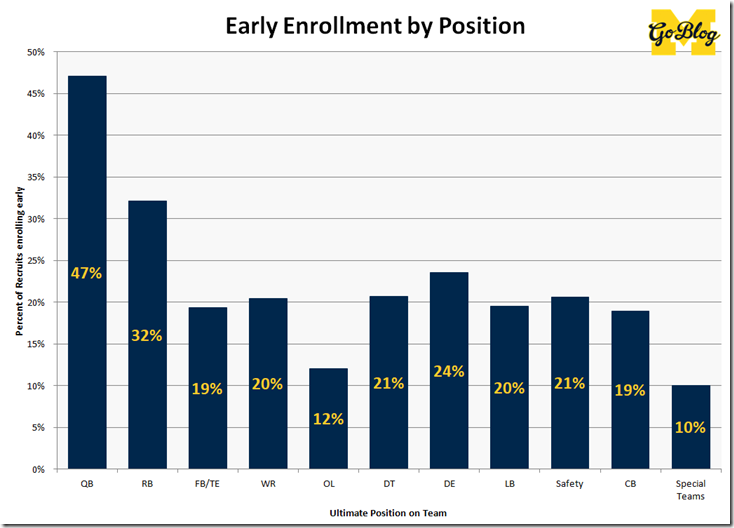
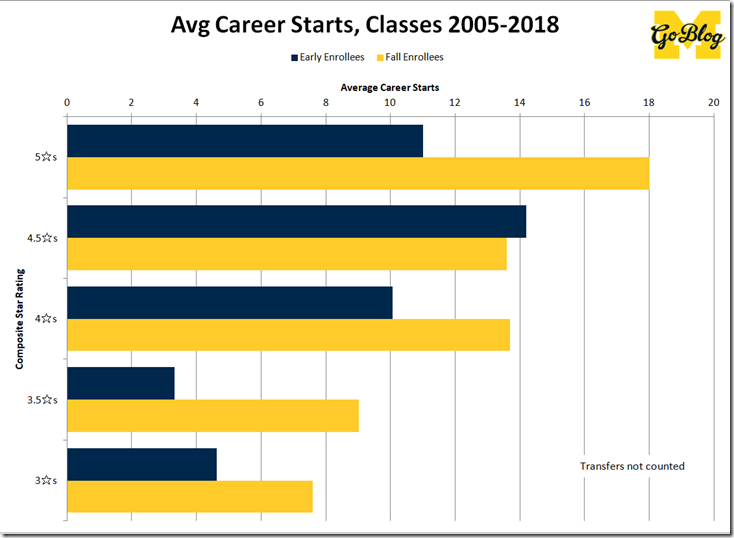
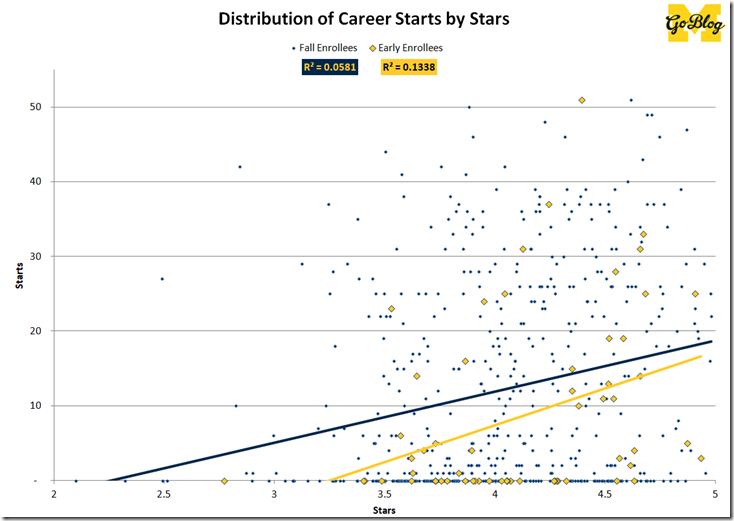
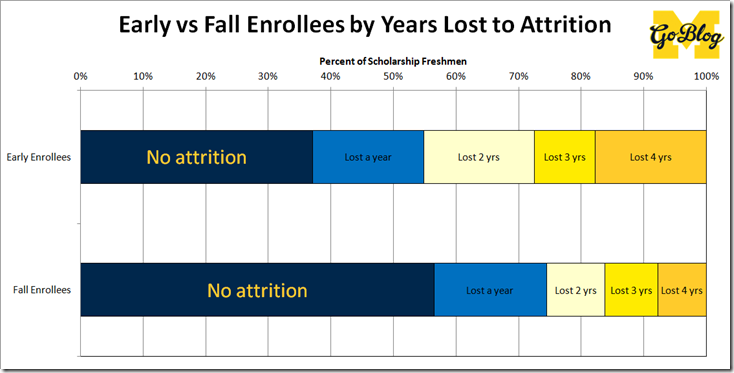
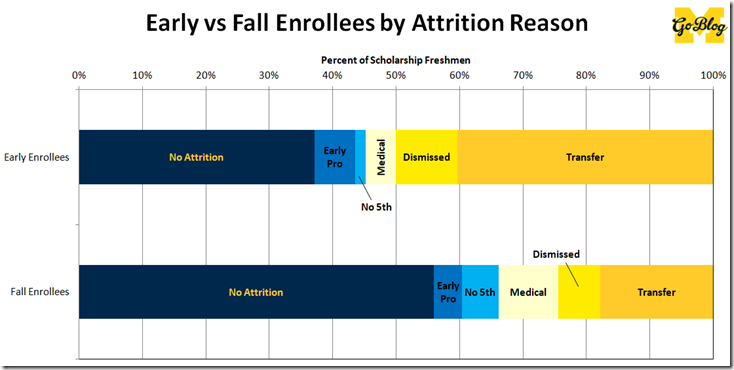
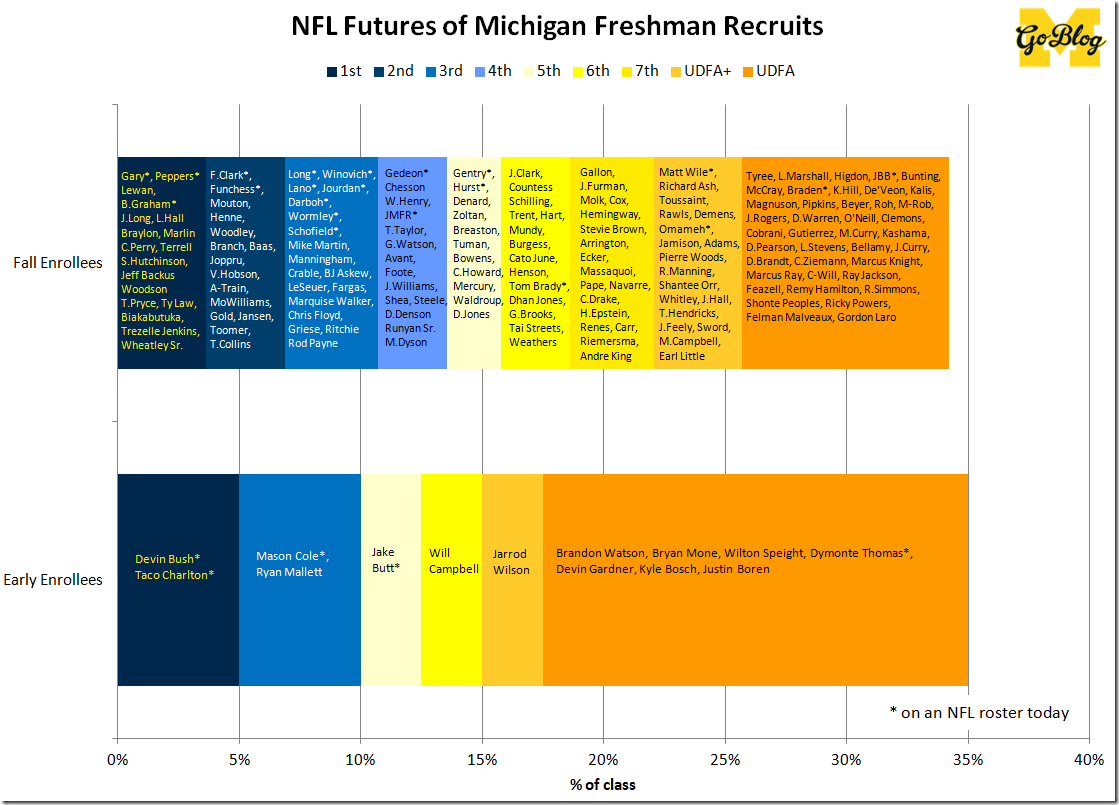
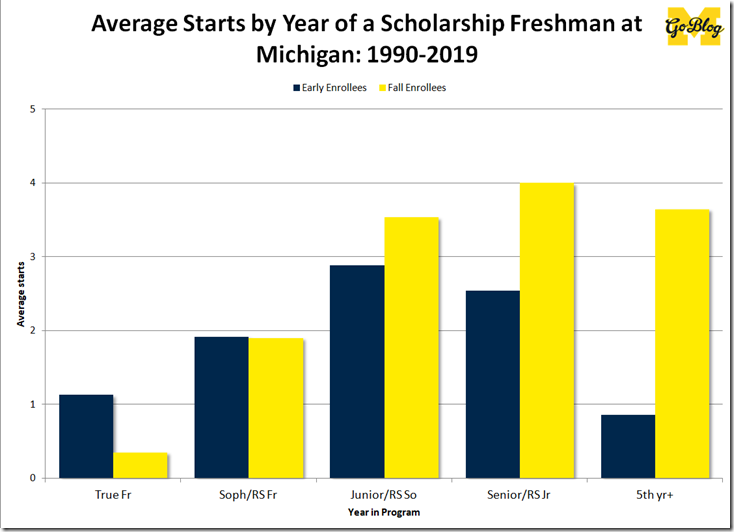
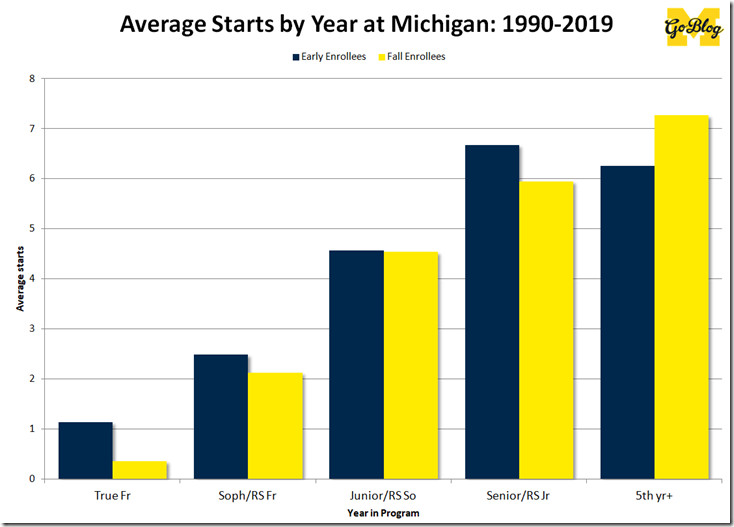
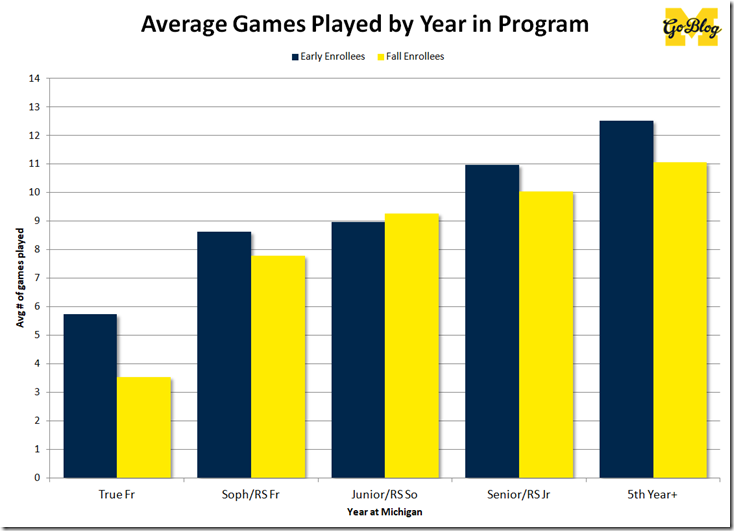
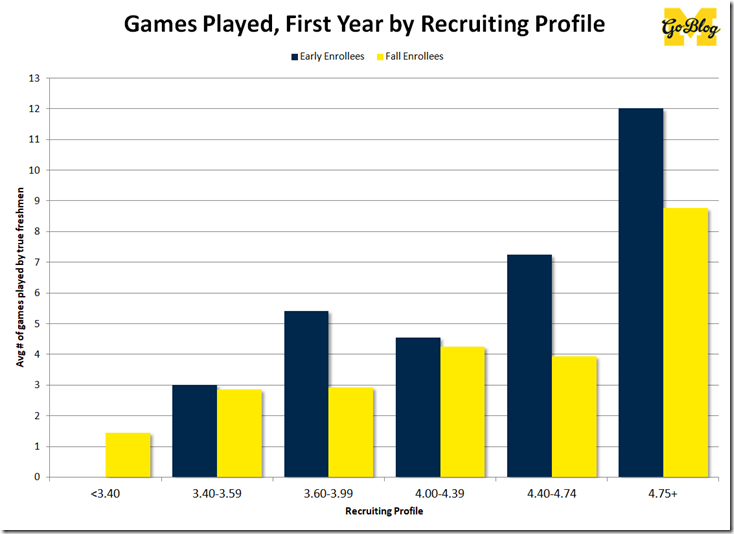
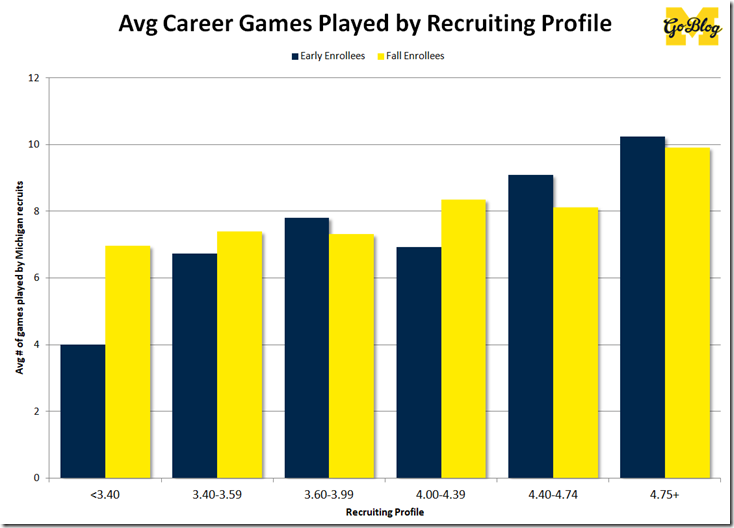
Comments